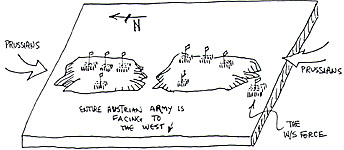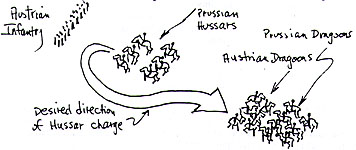At the February PW meeting, a Seven Years War battle was set up... Prussians versus Austrians. There were 5 gamers on the Austrian side, 4 on the Prussian. Of the 9 participants, only one really knew the rules, and it was slow, slow, slow going.
AGE OF REASON (AOR) was published sometime ago in the '80's, and I sat in on a game at one of the HMGS conventions hosted by the author... this was when the rules first came out. I believe this was at the same time that ON TO RICHMOND was at its peak of popularity, and Todd borrowed the ON TO RICHMOND sequence quite freely. Since that time, the wargaming world has largely ignored ON TO RICHMOND (it was replaced by Rich Hasenaeur's FIRE & FURY), but AOR seems to live on.
It is my opinion that one of the reasons for the demise of ON TO RICHMOND was its "carded" sequence. Each unit (brigade, division, etc... unit size depends upon the scale of the game) has its name on one card in a sequence deck. The cards are shuffled and drawn at random, and a unit moves only when its card is played. After all cards have been drawn, the firing sequence occurs, and then the melee phase is resolved.
With perhaps 12 to 20 units on the field, a participant wafts... and wafts... and wafts... until his unit card is drawn, then he moves his unit, and then he wafts some more until the rest of the sequence deck is played. I have noted that, many times, at ON TO RICHMOND games, because of the long wafting periods, players simply wander off, and when their unit card is drawn, they are not to be found (Where did Boris go? Has anyone seen Boris? Someone go and find Boris. It's his turn to move.').
We had 14 brigades on the field at our PW game... a 14 card sequence deck. To our undying credit, no-one wandered off during the game during critical moments, although at least one fella (me) lost patience.
Our sole rules-guru was always wanted in five places at once... this didn't help the rate of play, either, and the game was further held up as he adjucated fire fights and morale checks and melees...
Enough of belaboring the sequence... let's just say that, in my opinion, it's the worst sequence you can foist on an unsuspecting group of wargamers...
 The sketch shows the initial disposition of the Austrian command. All of the Austrian units, my brigade amongst them, were lined up on the field, facing west, awaiting the Prussian attack. The Prussians were not to be seen.
The sketch shows the initial disposition of the Austrian command. All of the Austrian units, my brigade amongst them, were lined up on the field, facing west, awaiting the Prussian attack. The Prussians were not to be seen.
"Har, har, har!", said the host, "You guys have been outfoxed and outflanked by Frederick the Great. His Prussian forces, although outnumbered, are coming at you from the north and south."
My initial command (which, due to my basic lack of patience, I soon handed over to Greg Whitaker) was on the far left flank of the Austrian line. And sure enough, just as the host had indicated, onto the field came Bob Hurst's Austrian cavalry brigade... 2 units, one of Hussars, one of Dragoons.
The Whitaker/Simon (henceforth to be referred to as W/S) force consisted of 2 brigades... the first of infantry (3 regiments of about 6 stands each, plus 2 guns), and the second of cavalry (one regiment of Lancers, one of Dragoons).
Seeing the Hurst cavalry appear, the W/S command staff shouted to its own cavalry "Charge!". Both of the W/S cavalry units took a "do-you-really-want-to-charge?" test... and both wimped out. I think each had to throw a total of 6 on 2 dice, and each failed. In contrast, both of the Hurst units succeeded, and came flying in, catching our regiments standing and in disorder.
Each cavalry unit got 2 basic dice (6-sided dice), and all modifiers were in terms of whole dice. After going through the long list of modifiers, in the Lancer-vs-Hussar combat, the W/S Lancers emerged with 3 dice, the Hurst Hussars with 7 dice.
I should note that in the sequence, charge declarations come first, units test to charge, and they are then placed in contact. There they sit, immobile, during the draw of the entire unitcard-sequence deck. Since they are "in melee", they cannot be fired on, and neither can they be reinforced by other units, since the 'charge declaration' phase is over.
In the cavalry melee, Bob Hurst's 7 dice totaled 21, our 3 dice totaled 12. Every 6 points in the total kills one enemy figure, hence Hurst killed 3 Lancers, we killed 2 Hussars. By definition, the side knocking off the greater number of figures wins the melee. Which meant that our wimpy Lancers fled, (some 28 inches. never to be seen again) going right through one of our infantry units, disordering it.
The victorious Hussars took some kind of control test, and pursued, running into our disordered infantry. Reference to the melee charts gave the cavalry 7 dice, the infantry 3 dice. This time the result was that the infantry drew back about 2 inches, holding on, but barely.
When the units lost men, those wonderful black casualty caps were adroitly placed over the heads of the concerned figures, and when a unit was disordered, a yellow pipe cleaner was placed beside it, and when the unit was routing, a red pipe cleaner was placed on it.
This is all very colorful, and I note that when the COURIER staff - Dick Bryant and company presents its games at the HMGS conventions, it uses the same colorful set-up... surely there must be something better than these atrocious-looking markers. But I must further note that I seem to be the only person who is bothered by these trifles... everyone else either doesn't see them at all, or ignores them.
And while noting such things, AOR has some 22 charts for reference for the conglomerate firing, melee, morale, charging, and whatever procedures. To my mind, you can't play the game without constant reference to these charts. Tony Figlia, one of the Prussian commanders, said "So what!" He indicated that his group used to play EMPIRE 3, which has even more charts, and the members of his gaming group had memorized all of the chart contents and rarely needed to look at them.
Now, if you believe that, you'll believe that DBM is historically realistic.
On the AOR small-arms firing chart, for example, there are 22 possible modifiers, with values ranging from +1 to -3. Other charts are similar in nature... I defy you to memorize them.
Our game ran 4 turns, i.e., 4 run-throughs of the sequence deck. Then there followed a wee bit of discussion as to who won... each side had something good to say about itself, and something bad to say about the opposition.
I concentrated mainly on the portion of the field occupied by the W/S force, and barely paid attention to what was going on on the rest of the field. But I did note that over on the northern portion, it looked as if nothing was happening. The opposing units faced each other and appeared to be immobile throughout the game.
One of the more silly occurrences in the game happened while our Austrian Dragoons were locked in combat with the Prussian Dragoons, and it's sketched out in the diagram below:

Note that Bob Hurst's Prussian Hussars were facing one of our Austrian infantry units, and their position placed them facing directly away from the Dragoon combat. Bob asked the game umpire if his unit could about-face, ignore the infantry and charge our Austrian cavalry in the rear.
"Certainly!" said the umpire, and Bob tossed his "do-you-really-want-to-charge?" dice. He was given one 6-sided die, and had to toss a 6 to let the charge proceed. Providence, however, stepped in, and Bob didn't get his 6. Thank heaven for little things!
Back to PW Review March 1997 Table of Contents
Back to PW Review List of Issues
Back to MagWeb Master Magazine List
© Copyright 1997 Wally Simon
This article appears in MagWeb (Magazine Web) on the Internet World Wide Web.
Other military history articles and gaming articles are available at http://www.magweb.com